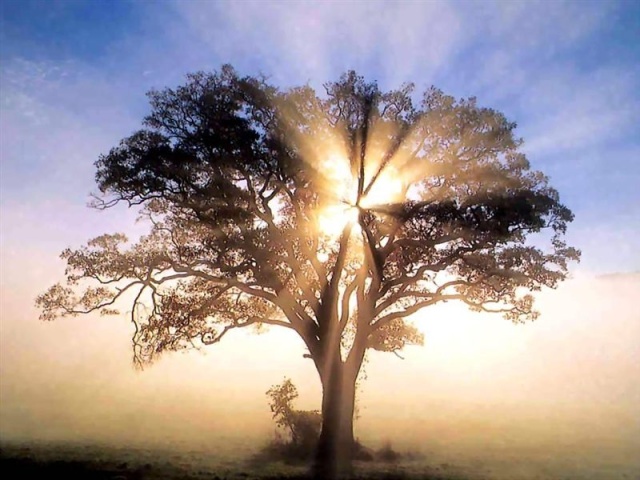By Clea Danaan
There has been a perceived rift for thousands of years between the sacredness of nature and the holiness of higher realms, be that from a Christian perspective (heaven, the soul, etc. being better, pure, vs. nature and humanity being sinful/fallen) or a New Age perspective (the elevation of "spirituality" over matter). Pagans know the earth as sacred, but some reject the notion that there is anything beyond the material realm, flipping the Christian and New Age approaches (sometimes in response to a sense of emptiness and vagueness felt in a Christian upbringing).
I believe, as a Christian and a Pagan (if we need labels to get where I'm coming from), that both are true and not mutually exclusive: both "heaven" and earth are sacred and of God/dess. Furthermore, it's not a dichotomy at all, but a continuous, dynamic, intertwined relationship of sacred creation. But I haven't yet found original spiritual teachings that offer real language for this wholeness and support what I am trying to say. And certainly not from a Christian perspective. Green Christians don't tend to regard the earth as sacred of it's own merit, but simply as something to steward out of duty to God. But as a practitioner of what might be called Dark Green Christianity, I see the land as sacred by it's very existence (please see Dark Green Religion by Bron Taylor for a discussion of dark green religion, the notion that earth is sacred from within).
I'm reading Cynthia Bourgeault's The Meaning of Mary Magdalene, where she offers, via the Gospel of Mary Magdalene, Jesus' teachings on this very subject. The Gospel of Mary Magdalene is a 5th century text discovered in Cairo in 1896. It was hidden when, in 594, the church determined which texts should and should not be a part of the canonical Bible (what we consider to be the Bible today). It is the teachings of Jesus after his crucifixion, much like Acts in the canonical Bible. The teachings, presented in a dialogue form, fly right over the heads of many Christians, in both the early days of the church and now, so it was distrusted and discounted. Contemporary scholars like Bourgeault are just now beginning to understand it and share it's meaning and significance.
The teachings in this gospel refute the notion that "this world is an illusion, or fall, or error; or that its density places it at the tail end of the chain" of realms of being. "Rather, this world is good, worthy, and fully inhabited by the divine energies - 'the Good comes among you' - so long as it stays united with its root" (Bourgeault, 52). Jesus came to earth - "the Good comes among you" - "in order to reunite everything to its origin" (from the Gospel of Mary Magdalene, Bourgeault, 46). He teaches that sin arises when we
fail to stay in alignment with this causal level origin (see Bourgeault,
48). About the causal realm, Jim Marion writes in Putting on the Mind of Christ, "This is the level of the Logos, the Eternal Word of God (John 1:1-3) through whom, as the firstborn of creation (Col. 1:15-20), all else of creation comes" (Marion, 184). The causal realm is the root of all, including the material world.
Jesus goes on to teach that we connect with the causal level - the root of all creation - through our heart, the organ of spiritual perception, an instrument of insight: "Blessed are the pure in heart, for they shall see God." (From a non-Christian perspective on the heart as an organ of psychic perception, see The Secret Teachings of Plants by Stephen Harrod Buhner.)
Jesus states, "All of nature with its forms and creatures exist together and are interwoven with each other" (Bourgeault, 46). By nature, he means the material world.
An artist paints to bring into the world a material form of a sense, a
feeling. We can know this sense, and the artist, by stepping back from
the painting and viewing it not from within the paint, but from a little
distance, in order to see it's real nature. And often we use our eyes
and our heart to do so.
Matter - nature - exists because of this higher causal level. It is, in other words, an expression or creation of the causal level (or rather of God, through the causal level). And we are here on this material plane to step back from the art work, if you will, in order to see it more clearly.We know God better through the forms and creatures of nature. And through our heart sensing of God as well as of nature.
Nature is, therefore, the most sacred of all master works, and needs to be treated accordingly. It is all sacred - as long as we stay centered and rooted in Source.Doesn't that just make you take a deep breath, settling into God within and without? As above, so below. Aho.
If this jumble of thoughts intrigues you, I highly recommend Cynthia Bourgeault's The Meaning of Mary Magdalene: Discovering the Woman at the Heart of Christianity as well as her Wisdom Jesus. Also Jim Marion's Putting on the Mind of Christ: The Inner Work of Christian Spirituality. Many Christians will find the ideas uncomfortable; others will find a sense of Yes! Non-Christians may find that the Christian approach is uncomfortable at first. If you are drawn to mysticism and wisdom traditions, stick with it. These are powerful texts that bring you to your center.

1 comment:
Thank you Clea. I found your books "Scared Land" and "Voices of the Earth" around Christmas this year. Have been savoring them both a little at a time. I really like this post and look forward to your suggested readings.
Post a Comment